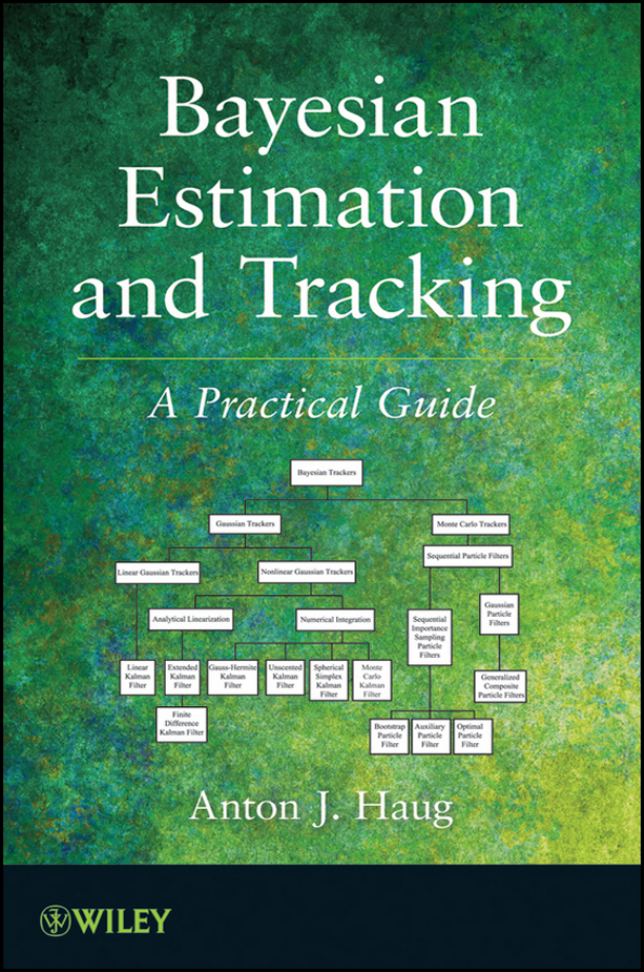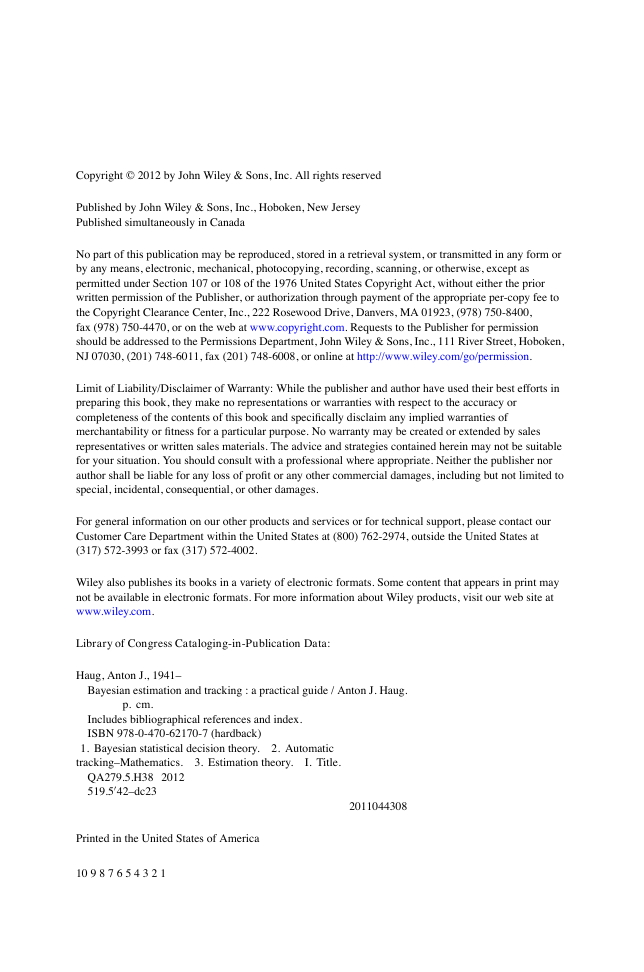Bayesian Estimation and Tracking: A Practical Guide
CONTENTS
PREFACE
ACKNOWLEDGMENTS
LIST OF FIGURES
LIST OF TABLES
PART I: PRELIMINARIES
1 Introduction
1.1 Bayesian Inference
1.2 Bayesian Hierarchy of Estimation Methods
1.3 Scope of This Text
1.3.1 Objective
1.3.2 Chapter Overview and Prerequisites
1.4 Modeling and Simulation with MATLAB®
References
2 Preliminary Mathematical Concepts
2.1 A Very Brief Overview of Matrix Linear Algebra
2.1.1 Vector and Matrix Conventions and Notation
2.1.2 Sums and Products
2.1.3 Matrix Inversion
2.1.4 Block Matrix Inversion
2.1.5 Matrix Square Root
2.2 Vector Point Generators
2.3 Approximating Nonlinear Multidimensional Functions withMultidimensional Arguments
2.3.1 Approximating Scalar Nonlinear Functions
2.3.2 Approximating Multidimensional Nonlinear Functions
2.4 Overview of Multivariate Statistics
2.4.1 General Definitions
2.4.2 The Gaussian Density
References
3 General Concepts of Bayesian Estimation
3.1 Bayesian Estimation
3.2 Point Estimators
3.3 Introduction to Recursive Bayesian Filtering of Probability DensityFunctions
3.4 Introduction to Recursive Bayesian Estimation of the State Mean andCovariance
3.4.1 State Vector Prediction
3.4.2 State Vector Update
3.5 Discussion of General Estimation Methods
References
4 Case Studies: Preliminary Discussions
4.1 The Overall Simulation/Estimation/Evaluation Process
4.2 A Scenario Simulator for Tracking a Constant Velocity TargetThrough a DIFAR Buoy Field
4.2.1 Ship Dynamics Model
4.2.2 Multiple Buoy Observation Model
4.2.3 Scenario Specifics
4.3 DIFAR Buoy Signal Processing
4.4 The DIFAR Likelihood Function
References
PART II: THE GAUSSIAN ASSUMPTION: A FAMILY OF KALMANFILTER ESTIMATORS
5 The Gaussian Noise Case: Multidimensional Integration ofGaussian-Weighted Distributions
5.1 Summary of Important Results From Chapter 3
5.2 Derivation of the Kalman Filter Correction (Update) EquationsRevisited
5.3 The General Bayesian Point Prediction Integrals for GaussianDensities
5.3.1 Refining the Process Through an Affine Transformation
5.3.2 General Methodology for Solving Gaussian-WeightedIntegrals
References
6 The Linear Class of Kalman Filters
6.1 Linear Dynamic Models
6.2 Linear Observation Models
6.3 The Linear Kalman Filter
6.4 Application of the LKF to DIFAR Buoy Bearing Estimation
References
7 The Analytical Linearization Class of Kalman Filters:The Extended Kalman Filter
7.1 One-Dimensional Consideration
7.1.1 One-Dimensional State Prediction
7.1.2 One-Dimensional State Estimation Error VariancePrediction
7.1.3 One-Dimensional Observation Prediction Equations
7.1.4 Transformation of One-Dimensional Prediction Equations
7.1.5 The One-Dimensional Linearized EKF Process
7.2 Multidimensional Consideration
7.2.1 The State Prediction Equation
7.2.2 The State Covariance Prediction Equation
7.2.3 Observation Prediction Equations
7.2.4 Transformation of Multidimensional PredictionEquations
7.2.5 The Linearized Multidimensional Extended Kalman FilterProcess
7.2.6 Second-Order Extended Kalman Filter
7.3 An Alternate Derivation of the Multidimensional CovariancePrediction Equations
7.4 Application of the EKF to the DIFAR Ship Tracking Case Study
7.4.1 The Ship Motion Dynamics Model
7.4.2 The DIFAR Buoy Field Observation Model
7.4.3 Initialization for All Filters of the Kalman Filter Class
7.4.4 Choosing a Value for the Acceleration Noise
7.4.5 The EKF Tracking Filter Results
References
8 The Sigma Point Class: The Finite Difference Kalman Filter
8.1 One-Dimensional Finite Difference Kalman Filter
8.1.1 One-Dimensional Finite Difference State Prediction
8.1.2 One-Dimensional Finite Difference State VariancePrediction
8.1.3 One-Dimensional Finite Difference Observation PredictionEquations
8.1.4 The One-Dimensional Finite Difference Kalman FilterProcess
8.1.5 Simplified One-Dimensional Finite Difference PredictionEquations
8.2 Multidimensional Finite Difference Kalman Filters
8.2.1 Multidimensional Finite Difference State Prediction
8.2.2 Multidimensional Finite Difference State CovariancePrediction
8.2.3 Multidimensional Finite Difference Observation PredictionEquations
8.2.4 The Multidimensional Finite Difference Kalman FilterProcess
8.3 An Alternate Derivation of the Multidimensional Finite DifferenceCovariance Prediction Equations
References
9 The Sigma Point Class: The Unscented Kalman Filter
9.1 Introduction to Monomial Cubature Integration Rules
9.2 The Unscented Kalman Filter
9.2.1 Background
9.2.2 The UKF Developed
9.2.3 The UKF State Vector Prediction Equation
9.2.4 The UKF State Vector Covariance Prediction Equation
9.2.5 The UKF Observation Prediction Equations
9.2.6 The Unscented Kalman Filter Process
9.2.7 An Alternate Version of the Unscented Kalman Filter
9.3 Application of the UKF to the DIFAR Ship Tracking Case Study
References
10 The Sigma Point Class: The Spherical Simplex Kalman Filter
10.1 One-Dimensional Spherical Simplex Sigma Points
10.2 Two-Dimensional Spherical Simplex Sigma Points
10.3 Higher Dimensional Spherical Simplex Sigma Points
10.4 The Spherical Simplex Kalman Filter
10.5 The Spherical Simplex Kalman Filter Process
10.6 Application of the SSKF to the DIFAR Ship Tracking Case Study
Reference
11 The Sigma Point Class: The Gauss–Hermite Kalman Filter
11.1 One-Dimensional Gauss–Hermite Quadrature
11.2 One-Dimensional Gauss–Hermite Kalman Filter
11.3 Multidimensional Gauss–Hermite Kalman Filter
11.4 Sparse Grid Approximation for High Dimension/High PolynomialOrder
11.5 Application of the GHKF to the DIFAR Ship Tracking Case Study
References
12 The Monte Carlo Kalman Filter
12.1 The Monte Carlo Kalman Filter
Reference
13 Summary of Gaussian Kalman Filters
13.1 Analytical Kalman Filters
13.2 Sigma Point Kalman Filters
13.3 A More Practical Approach to Utilizing the Family of KalmanFilters
References
14 Performance Measures for the Family of Kalman Filters
14.1 Error Ellipses
14.1.1 The Canonical Ellipse
14.1.2 Determining the Eigenvalues of P
14.1.3 Determining the Error Ellipse Rotation Angle
14.1.4 Determination of the Containment Area
14.1.5 Parametric Plotting of Error Ellipse
14.1.6 Error Ellipse Example
14.2 Root Mean Squared Errors
14.3 Divergent Tracks
14.4 Cramer–Rao Lower Bound
14.4.1 The One-Dimensional Case
14.4.2 The Multidimensional Case
14.4.3 A Recursive Approach to the CRLB
14.4.4 The Cramer–Rao Lower Bound for Gaussian AdditiveNoise
14.4.5 The Gaussian Cramer–Rao Lower Bound with Zero ProcessNoise
14.4.6 The Gaussian Cramer–Rao Lower Bound with LinearModels
14.5 Performance of Kalman Class DIFAR Track Estimators
References
PART III: MONTE CARLO METHODS
15 Introduction to Monte Carlo Methods
15.1 Approximating a Density From a Set of Monte Carlo Samples
15.1.1 Generating Samples from a Two-Dimensional GaussianMixture Density
15.1.2 Approximating a Density by Its MultidimensionalHistogram
15.1.3 Kernel Density Approximation
15.3 Summary
References
16 Sequential Importance Sampling Particle Filters
16.1 General Concept of Sequential Importance Sampling
16.2 Resampling and Regularization (Move) for SIS Particle Filters
16.2.1 The Inverse Transform Method
16.2.2 SIS Particle Filter with Resampling
16.2.3 Regularization
16.3 The Bootstrap Particle Filter
16.3.1 Application of the BPF to DIFAR Buoy Tracking
16.4 The Optimal SIS Particle Filter
16.4.1 Gaussian Optimal SIS Particle Filter
16.4.2 Locally Linearized Gaussian Optimal SIS Particle Filter
16.5 The SIS Auxiliary Particle Filter
16.5.1 Application of the APF to DIFAR Buoy Tracking
16.6 Approximations to the SIS Auxiliary Particle Filter
16.6.1 The Extended Kalman Particle Filter
16.6.2 The Unscented Particle Filter
16.7 Reducing the Computational Load ThroughRao-Blackwellization
References
17 The Generalized Monte Carlo Particle Filter
17.1 The Gaussian Particle Filter
17.2 The Combination Particle Filter
17.2.1 Application of the CPF–UKF to DIFAR Buoy Tracking
17.3 Performance Comparison of All DIFAR Tracking Filters
References
PART IV: ADDITIONAL CASE STUDIES
18 A Spherical Constant Velocity Model for Target Trackingin Three Dimensions
18.1 Tracking a Target in Cartesian Coordinates
18.1.1 Object Dynamic Motion Model
18.1.2 Sensor Data Model
18.1.3 GaussianTracking Algorithms for a Cartesian StateVector
18.2 Tracking a Target in Spherical Coordinates
18.2.1 State Vector Position and Velocity Components in SphericalCoordinates
18.2.2 Spherical State Vector Dynamic Equation
18.2.3 Observation Equations with a Spherical State Vector
18.2.4 GaussianTracking Algorithms for a Spherical StateVector
18.3 Implementation of Cartesian and Spherical Tracking Filters
18.3.1 Setting Values for q
18.3.2 Simulating Radar Observation Data
18.3.3 Filter Initialization
18.4 Performance Comparison for Various Estimation Methods
18.4.1 Characteristics of the Trajectories Used for PerformanceAnalysis
18.4.2 Filter Performance Comparisons
18.5 Some Observations and Future Considerations
APPENDIX 18.A: Three-Dimensional Constant Turn Rate Kinematics
18.A.1 General Velocity Components for Constant Turn RateMotion
18.A.2 General Position Components for Constant Turn RateMotion
18.A.3 Combined Trajectory Transition Equation
18.A.4 Turn Rate Setting Based on a Desired Turn Acceleration
APPENDIX 18.B: Three-Dimensional Coordinate Transformations
18.B.1 Cartesian-to-Spherical Transformation
18.B.2 Spherical-to-Cartesian Transformation
References
19 Tracking a Falling Rigid Body Using Photogrammetry
19.1 Introduction
19.2 The Process (Dynamic) Model for Rigid Body Motion
19.2.1 Dynamic Transition of the Translational Motion of a RigidBody
19.2.2 Dynamic Transition of the Rotational Motion of a RigidBody
19.2.3 Combined Dynamic Process Model
19.2.4 The Dynamic Process Noise Models
19.3 Components of the Observation Model
19.4 Estimation Methods
19.4.1 A Nonlinear Least Squares Estimation Method
19.4.2 An Unscented Kalman Filter Method
19.4.3 Estimation Using the Unscented Combination ParticleFilter
19.4.4 Initializing the Estimator
19.5 The Generation of Synthetic Data
19.5.1 Synthetic Rigid Body Feature Points
19.5.2 Synthetic Trajectory
19.5.3 Synthetic Cameras
19.5.4 Synthetic Measurements
19.6 Performance Comparison Analysis
19.6.1 Filter Performance Comparison Methodology
19.6.2 Filter Comparison Results
19.6.3 Conclusions and Future Considerations
APPENDIX 19.A: Quaternions, Axis-Angle Vectors, and Rotations
19.A.1 Conversions Between Rotation Representations
19.A.2 Representation of Orientation and Rotation
19.A.3 Point Rotations and Frame Rotations
References
20 Sensor Fusion Using Photogrammetric and Inertial Measurements
20.1 Introduction
20.2 The Process (Dynamic) Model for Rigid Body Motion
20.3 The Sensor Fusion Observational Model
20.3.1 The Inertial Measurement Unit Component of theObservation Model
20.3.2 The Photogrammetric Component of the ObservationModel
20.3.3 The Combined Sensor Fusion Observation Model
20.4 The Generation of Synthetic Data
20.4.1 Synthetic Trajectory
20.4.2 Synthetic Cameras
20.4.3 Synthetic Measurements
20.5 Estimation Methods
20.5.1 Initial Value Problem Solver for IMU Data
20.6 Performance Comparison Analysis
20.6.1 Filter Performance Comparison Methodology
20.6.2 Filter Comparison Results
20.7 Conclusions
20.8 Future Work
References
Index
















 2023年江西萍乡中考道德与法治真题及答案.doc
2023年江西萍乡中考道德与法治真题及答案.doc 2012年重庆南川中考生物真题及答案.doc
2012年重庆南川中考生物真题及答案.doc 2013年江西师范大学地理学综合及文艺理论基础考研真题.doc
2013年江西师范大学地理学综合及文艺理论基础考研真题.doc 2020年四川甘孜小升初语文真题及答案I卷.doc
2020年四川甘孜小升初语文真题及答案I卷.doc 2020年注册岩土工程师专业基础考试真题及答案.doc
2020年注册岩土工程师专业基础考试真题及答案.doc 2023-2024学年福建省厦门市九年级上学期数学月考试题及答案.doc
2023-2024学年福建省厦门市九年级上学期数学月考试题及答案.doc 2021-2022学年辽宁省沈阳市大东区九年级上学期语文期末试题及答案.doc
2021-2022学年辽宁省沈阳市大东区九年级上学期语文期末试题及答案.doc 2022-2023学年北京东城区初三第一学期物理期末试卷及答案.doc
2022-2023学年北京东城区初三第一学期物理期末试卷及答案.doc 2018上半年江西教师资格初中地理学科知识与教学能力真题及答案.doc
2018上半年江西教师资格初中地理学科知识与教学能力真题及答案.doc 2012年河北国家公务员申论考试真题及答案-省级.doc
2012年河北国家公务员申论考试真题及答案-省级.doc 2020-2021学年江苏省扬州市江都区邵樊片九年级上学期数学第一次质量检测试题及答案.doc
2020-2021学年江苏省扬州市江都区邵樊片九年级上学期数学第一次质量检测试题及答案.doc 2022下半年黑龙江教师资格证中学综合素质真题及答案.doc
2022下半年黑龙江教师资格证中学综合素质真题及答案.doc